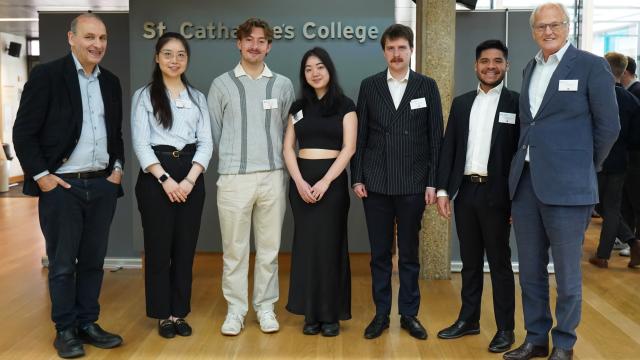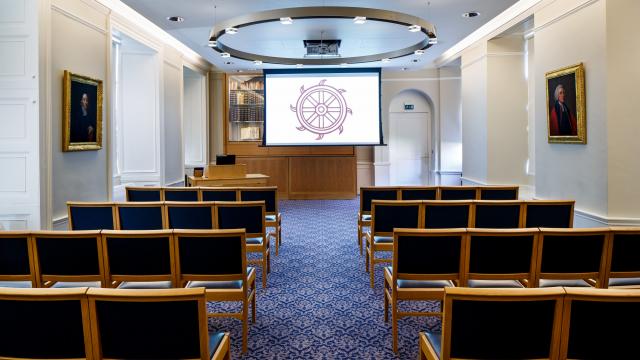
A new exhibition celebrating the Italian natural philosopher Alessandro Volta (1745–1827) is on display at St Catharine’s until the end of October 2023. The exhibition has been possible thanks to alumnus and Fellow Dr Peter Wothers (1988, Natural Sciences; Fellow 1997) showcasing items on loan from his personal collection as well as acquiring two important pieces for the College with the generous financial support of donor Keith Sykes:
- An exceedingly rare copy of Volta’s Proposizioni e sperienze di aerologia (part of the St Catharine’s collection since 2021)
- A possibly unique uncut sheet of Volta’s Sull'aria Infiammabile Nativa Delle Paludi (added to the St Catharine’s collection in May 2023)
Whilst Volta is perhaps best known for his electrical research (especially since he is honoured with a scientific unit named after him), some of his earliest work was in the field of chemistry, particularly the investigations of gases, or pneumatic chemistry. Volta’s findings from this period culminated in the aerologia, his first chemical publication.
Dr Wothers said, “Only three copies of Volta’s aerologia (including the one now at Catz) are recorded worldwide and it always had a reputation for being rare: in his bibliography of Volta published in 1877, Riccardi complained that he could not give an accurate description of the aerologia publication since it had been impossible for him to see a single copy – and even Volta himself lamented in 1804 that he was unable to find a copy!
“In this work, after a brief survey of the mechanical properties of air, Volta looks at the chemical properties of different kinds of airs, or gases as we would now say. He refers extensively to Priestley who had announced the discovery and characterisation of several gases, including, in 1775, ‘dephlogisticated air’ – the gas we now call oxygen."
|
|
|
Following a suggestion from Padre Carlo Campi, Volta investigated the bubbles of gas that were emitted from putrefying plant matter at the bottom of lakes and ditches in the region around Lake Como. He discovered a new type of ‘inflammable air’ (methane) which he carefully distinguished from the other ‘inflammable air’ (hydrogen) obtained from the reaction between certain metals with acids and characterised by Henry Cavendish in 1766.
Volta’s discovery is illustrated in one of the charming vignettes from his publication Sull'aria Infiammabile Nativa Delle Paludi (On the inflammable air native to swamp marshes). This work, published in Milan in 1777, consists of seven letters, but the first two of these were published the previous year. One of the copies included in the exhibition is possibly unique, still in the form of a single sheet as it had been printed and left uncut and unbound. The way the text form is laid out (known as the imposition) is such that when folded (and the edges cut), all the pages appear the right way round and in the right order, as shown in the standard copy of the booklet on display beside it.
In the fourth letter in the 1777 book, Volta describes how mixtures of his new inflammable air and air or, better still, oxygen (Priestley’s dephlogisticated air) could be ignited using an electric spark as delivered by the static electricity stored in a capacitor. He considers that one ought to be able to construct an inflammable air ‘gun’. This he describes in three letters to Francesco Castelli: Lettere del Sig. D. Alessandro Volta al Sig. Marchese Francesco Castelli, sopra alla costruzione di un moschetto e d'una pistola ad aria infiammabile, 1777. His illustration shows some rudimentary ‘pistols’, which he emphasises, are not intended for military use.
The items on display from Dr Wothers’ own collection include a gas pistol designed by Jan Ingen-Housz (best known for his discovery of photosynthesis) and built by the famous instrument makers Nairn and Blunt.
Dr Wothers explained, “As described in the accompanying paper from 1779, the gas pistol is designed to work using a drop or two of the very volatile fluid aether (diethyl ether) – far more convenient that having to prepare the ‘inflammable air’. ‘Dephlogisticated air’ (oxygen) contained in a bladder may be introduced into the chamber through the brass stopcock – traces of a bladder may still be seen on this apparatus. The explosion produced with pure oxygen is quite considerable and resulted in earlier versions of the apparatus being destroyed.”
The exhibition also celebrates Volta’s contributions to the development of the inflammable gas eudiometer (an instrument designed to try to measure the ‘goodness’ of air – essentially, the proportion of oxygen in the air). Volta advanced the apparatus by developing versions in which mixtures of air or oxygen could be exploded with inflammable gases. On display is an early nineteenth-century example of the apparatus and Volta’s final papers on the subject in the first volume of the Annali di Chimica, 1790, edited by Brugnatelli. A detailed description and illustration is also displayed from a copy of A compendium of the course of chemical instruction in the medical department of the University of Pennsylvania by Robert Hare, M.D. 1827.
In addition, the exhibition features an example of the famous ‘Voltaic pile’, which consists of multiple pairs of zinc and copper discs (or better still zinc and silver discs), separated by the soaked discs of card/cloth. The pile in this case consists of 15 pairs of copper and zinc. The more pairs, the stronger the electrical force (now measured in volts).
Dr Wothers added, “The significance of this invention is that it represents the first modern battery – an apparatus capable of providing a continuous electrical current, as distinct from the electrical discharges from stored up static electricity previously employed in experiments. It arose after Luigi Galvani famously observed the twitching of dissected frogs’ legs when stimulated by electricity. Whilst Galvani thought such effects were due to an intrinsic electricity of the animal itself, Volta soon suspected it was due to an artificial electricity due to the contact of different metals. Seeking a way to amplify the electrical effect, Volta eventually came to the idea of connecting series of pairs of different metals, either dipped in solution, or eventually separating pairs with card or cloth soaked in aqueous acid or salts.”
An accompanying plate from Moratelli’s Memorie fisico-chimiche, Venice 1805 and shows the voltaic piles and experiments being performed with them. The electrical stimulation of body parts (both animal and human) are reminiscent of Galvani’s experiments – some of which are said to have helped inspire Mary Shelly’s creation of Frankenstein and his monster; Frankenstein is described as an enthusiastic student of chemistry.
Volta first announced the discovery of his battery in a letter dated 30 March 1800 to the President of the Royal Society, Sir Joseph Banks. This was read to the Royal Society in June, but in April Banks showed the letter to surgeon Anthony Carlisle who rapidly constructed his own pile using 17 silver half-crown coins and matching discs of copper. Working with William Nicholson, after first using the pile to shock themselves in the arm, the pair carried out more serious investigations, eventually leading to the electrolysis of water, splitting the water into its component gases hydrogen and oxygen. This milestone achievement was first published in the July issue of Nicholson’s journal, which also appears in the exhibition.
As other scientists further investigated the electrolysis of water, they noticed the presence of acid and alkali around the poles and that the theoretical yields of oxygen and hydrogen were not attained. Sir Humphry Davy’s definitive paper on the subject from 1806 is included in the exhibition: he proved that when pure water, redistilled in silver apparatus, was electrolyzed in gold or agate vessels under an atmosphere of hydrogen (so that nitrogen could not combine with the nascent gases), it was decomposed into oxygen and hydrogen only in their theoretical proportions. The copy exhibited is a presentation copy of the rare offprint, inscribed to the Right Honourable C. F. Greville, FRS, whose magnificent mineral collection was purchased via Act of Parliament for the British Museum. The following year, Davy used an enormous modified voltaic cell to prepare, for the first time, the metals sodium and potassium.
The exhibition can be found opposite the St Catharine’s dining hall and displayed in the purpose-built case in the atrium, which was installed as part of the Central Spaces building project last year.









